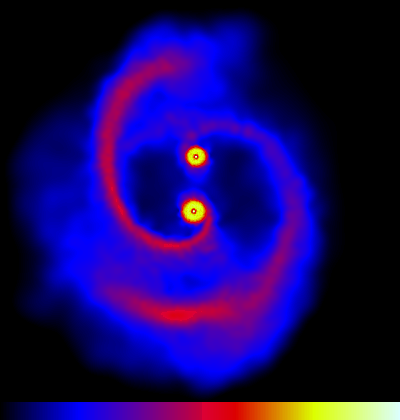Matthew Bate's AnimationsCopyright and other information can be found at the bottom of this page.Dust coagulation during the early stages of star formation: molecular cloud collapse and first hydrostatic core evolution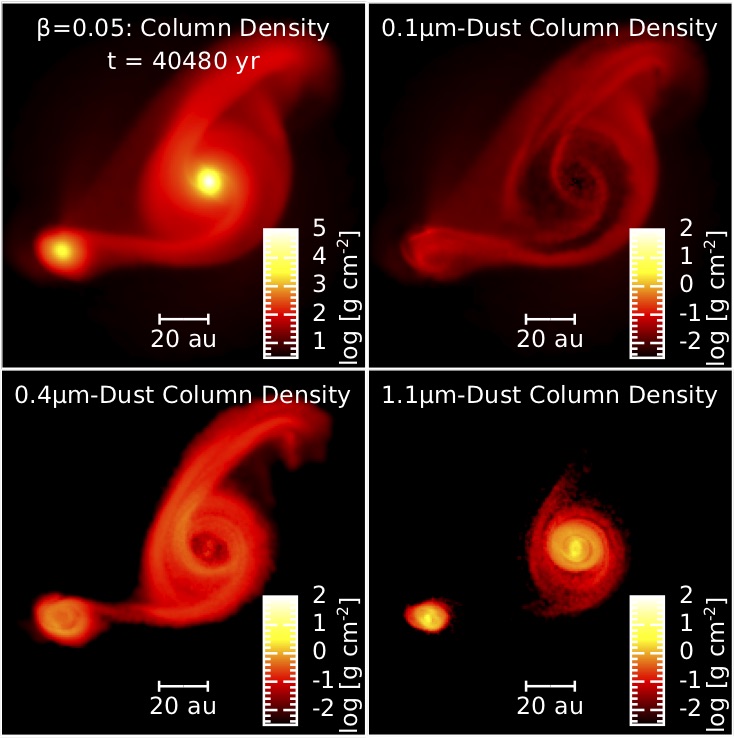 We present results from the first study of dust grain growth during the earliest phases of star formation using three-dimensional hydrodynamical simulations. We begin with a typical interstellar dust grain size distribution and study dust growth during the collapse of a molecular cloud core and the evolution of the first hydrostatic core, prior to the formation of the stellar core. Once the first hydrostatic core forms rapid dust growth to sizes in excess of 100 micron occurs within the core (before stellar core formation), with larger grains closer to the centre of the core. In gravitationally-unstable discs, grain growth is more rapid in the spiral density waves leading to the larger grains being preferentially found in the spiral waves even though there is no migration of grains relative to the gas. Thus, the grain size distribution can vary substantially in the first core/pre-stellar disc even at these very early times.
More information.
We present results from the first study of dust grain growth during the earliest phases of star formation using three-dimensional hydrodynamical simulations. We begin with a typical interstellar dust grain size distribution and study dust growth during the collapse of a molecular cloud core and the evolution of the first hydrostatic core, prior to the formation of the stellar core. Once the first hydrostatic core forms rapid dust growth to sizes in excess of 100 micron occurs within the core (before stellar core formation), with larger grains closer to the centre of the core. In gravitationally-unstable discs, grain growth is more rapid in the spiral density waves leading to the larger grains being preferentially found in the spiral waves even though there is no migration of grains relative to the gas. Thus, the grain size distribution can vary substantially in the first core/pre-stellar disc even at these very early times.
More information.
Reference: Bate 2022;
Date first added: 05/2022;
The dependence of stellar properties on metallicity (2019)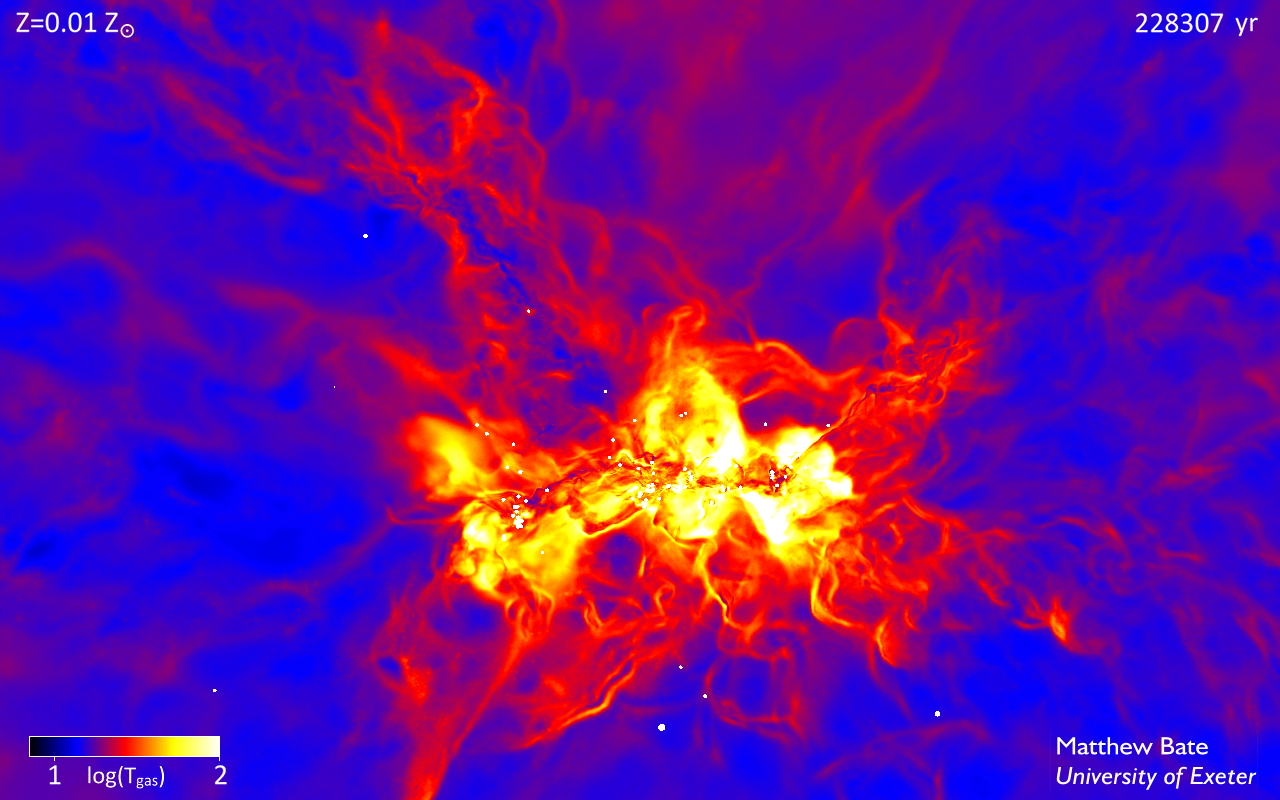 Radiation hydrodynamical simulations of star formation in a 500 solar-mass molecular cloud with different metallicities, ranging from 1/100 to 3 times solar metallicity. For the first time, these calculations treat separate gas and dust temperatures and include a model for the diffuse interstellar medium and a simple chemical model. It is found that close binary systems are more frequent at lower metallicity, due to enhanced cooling and fragmentation on small spatial scales. More information.
Radiation hydrodynamical simulations of star formation in a 500 solar-mass molecular cloud with different metallicities, ranging from 1/100 to 3 times solar metallicity. For the first time, these calculations treat separate gas and dust temperatures and include a model for the diffuse interstellar medium and a simple chemical model. It is found that close binary systems are more frequent at lower metallicity, due to enhanced cooling and fragmentation on small spatial scales. More information.
Reference: Bate 2019;
Date first added: 01/2019;
On the diversity and statistical properties of protostellar discs (2018)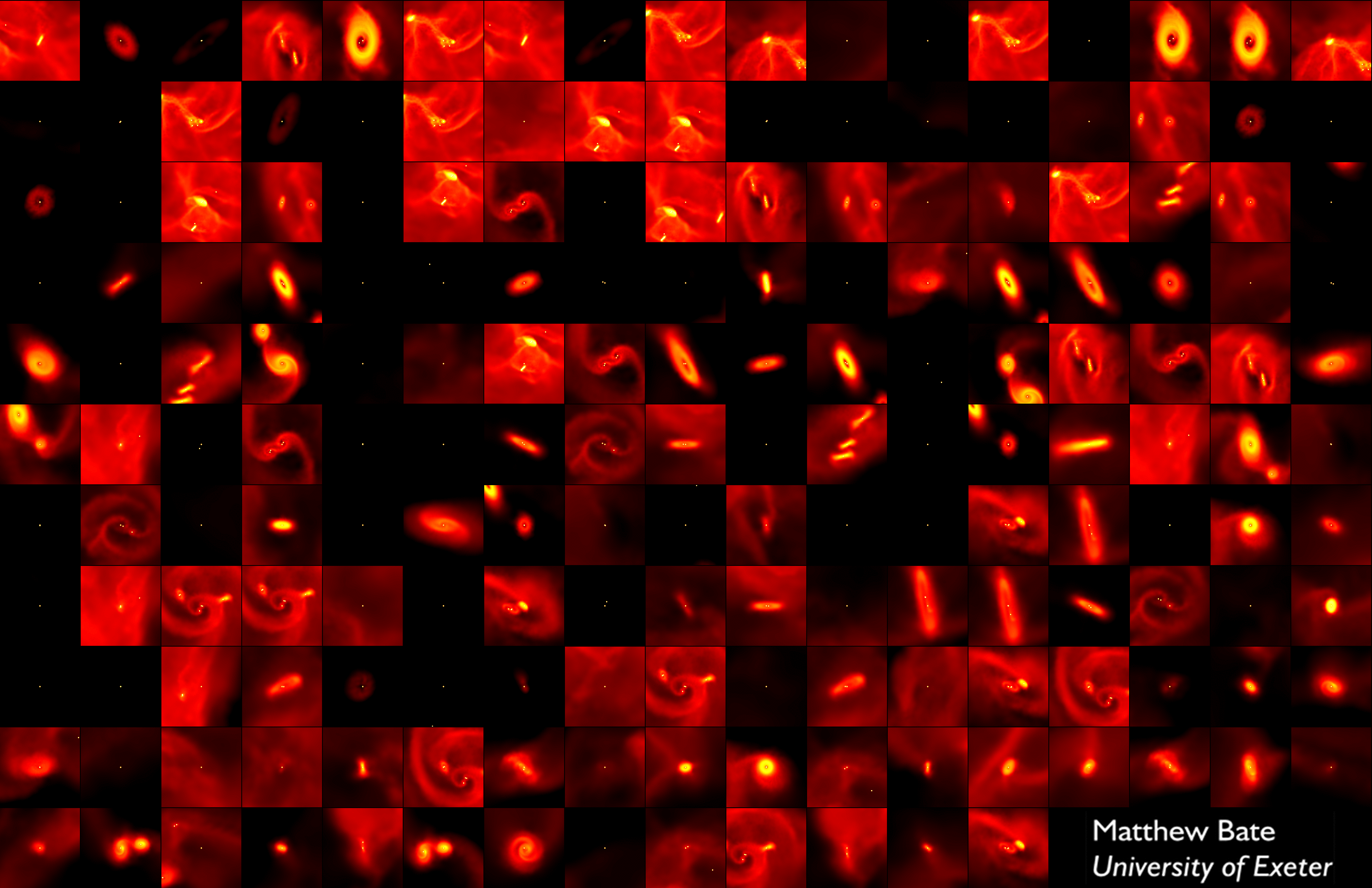 We present results from the first population synthesis study of protostellar discs. We analyse the evolution and properties of a large sample of protostellar discs formed in a radiation hydrodynamical simulation of star cluster formation.
Due to the chaotic nature of the star formation process, we find an enormous diversity of young protostellar discs, including misaligned discs, and discs whose orientations vary with time. Star-disc interactions truncate discs and produce multiple systems.
Discs may be destroyed in dynamical encounters and/or through ram-pressure stripping, but reform by later gas accretion.
We quantify the distributions of disc mass and radii for protostellar ages up to ≈ 105 yrs.
More information.
We present results from the first population synthesis study of protostellar discs. We analyse the evolution and properties of a large sample of protostellar discs formed in a radiation hydrodynamical simulation of star cluster formation.
Due to the chaotic nature of the star formation process, we find an enormous diversity of young protostellar discs, including misaligned discs, and discs whose orientations vary with time. Star-disc interactions truncate discs and produce multiple systems.
Discs may be destroyed in dynamical encounters and/or through ram-pressure stripping, but reform by later gas accretion.
We quantify the distributions of disc mass and radii for protostellar ages up to ≈ 105 yrs.
More information.
Reference: Bate 2018;
Date first added: 01/2018;
On the dynamics of dust during protostellar collapse (2016)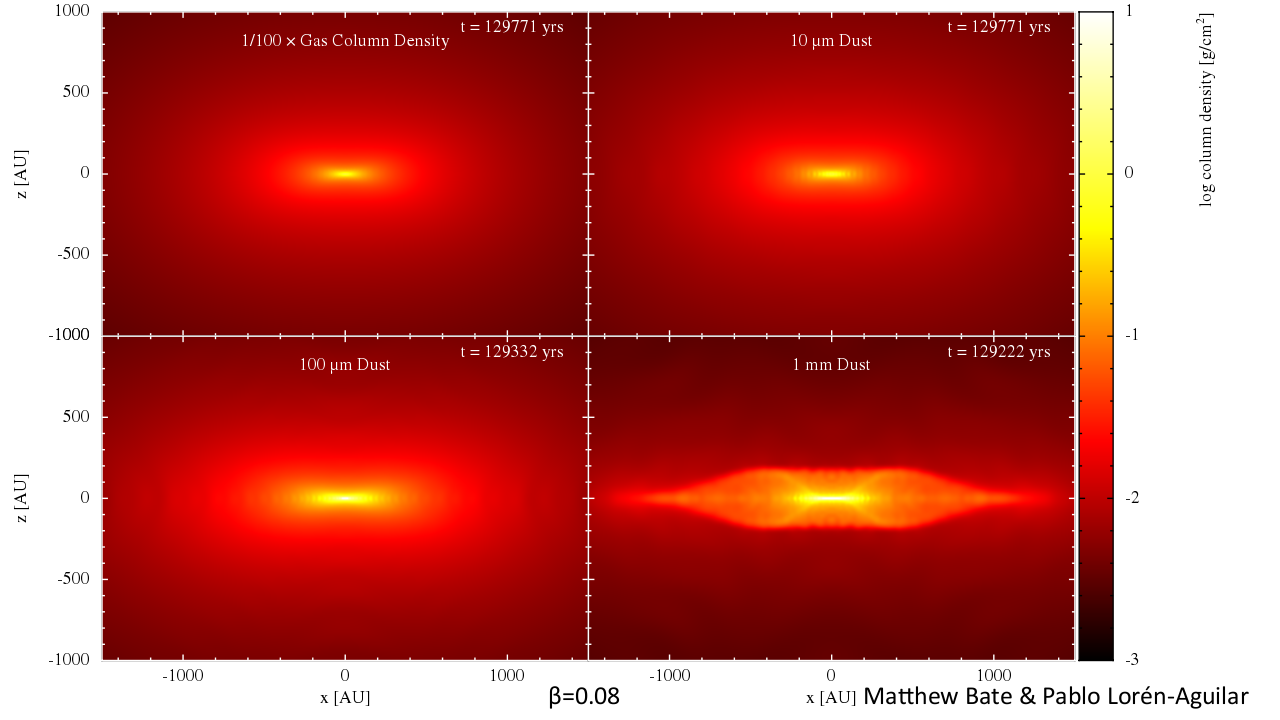 We study the evolution of dust and gas during the collapse of rotating molecular cloud cores.
We show that the dynamics of the dust depends on its size. Dust particles with sizes <10 microns are well-coupled to the gas during the collapse and there is little variation of the dust-to-gas ratio. However, larger dust grains (e.g. 100 micron or 1 mm) have trajectories that are very different from the gas, leading to mid-plane settling and/or oscillations if the dust through the mid-plane.
This may produce variations in the dust-to-gas ratio and very different distributions of large and small dust grains at the very earliest stages of star formation, if large grains are present in pre-stellar cores. More information.
We study the evolution of dust and gas during the collapse of rotating molecular cloud cores.
We show that the dynamics of the dust depends on its size. Dust particles with sizes <10 microns are well-coupled to the gas during the collapse and there is little variation of the dust-to-gas ratio. However, larger dust grains (e.g. 100 micron or 1 mm) have trajectories that are very different from the gas, leading to mid-plane settling and/or oscillations if the dust through the mid-plane.
This may produce variations in the dust-to-gas ratio and very different distributions of large and small dust grains at the very earliest stages of star formation, if large grains are present in pre-stellar cores. More information.
Reference: Bate & Loren-Aguilar 2016;
Date first added: 11/2016;
Toridal vortices as a solution to the dust migration problem (2016)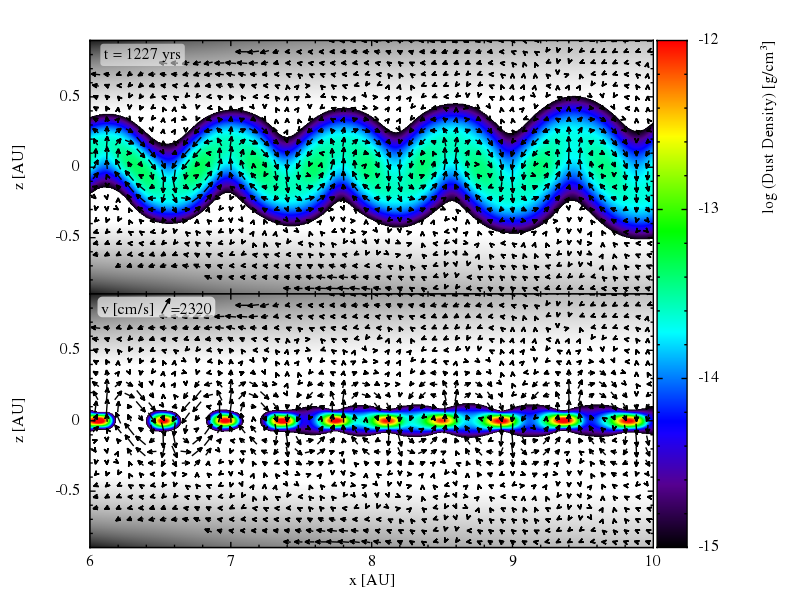 We investigate the evolution of a dusty protoplanetary disc with two different dust species (1 mm and 50 cm dust grains), under the presence of the toroidal vortex instability. We show how toroidal vortices, triggered by the interaction of mm grains with the gas, stop the radial migration of metre-sized dust, potentially offering a natural and efficient solution to the dust migration problem. More information.
We investigate the evolution of a dusty protoplanetary disc with two different dust species (1 mm and 50 cm dust grains), under the presence of the toroidal vortex instability. We show how toroidal vortices, triggered by the interaction of mm grains with the gas, stop the radial migration of metre-sized dust, potentially offering a natural and efficient solution to the dust migration problem. More information.
Reference: Loren-Aguilar & Bate 2016;
Date first added: 01/2016;
Toridal vortices and the conglomeration of dust into rings in protoplanetary discs (2015)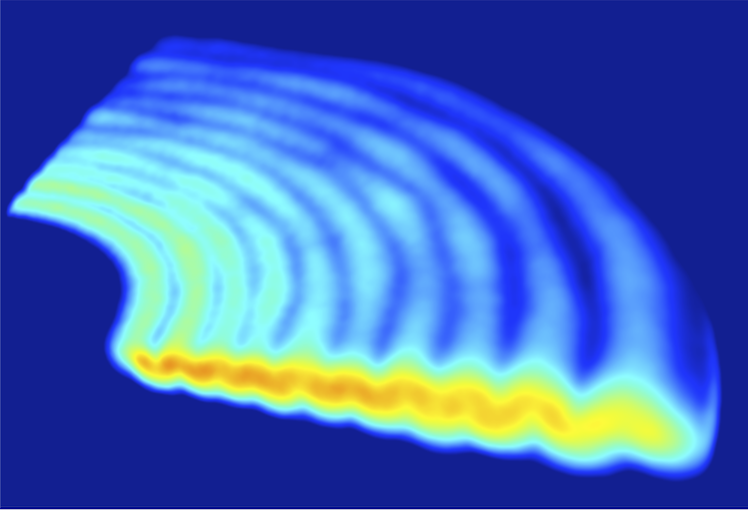 We report a new hydrodynamical instability in protoplanetary discs that may arise due to variations in the dust-to-gas ratio and may lead to concentration of dust grains within a disc. More information.
We report a new hydrodynamical instability in protoplanetary discs that may arise due to variations in the dust-to-gas ratio and may lead to concentration of dust grains within a disc. More information.
Reference: Loren-Aguilar & Bate 2015;
Date first added: 07/2015;
The dependence of star cluster formation on metallicity (2014)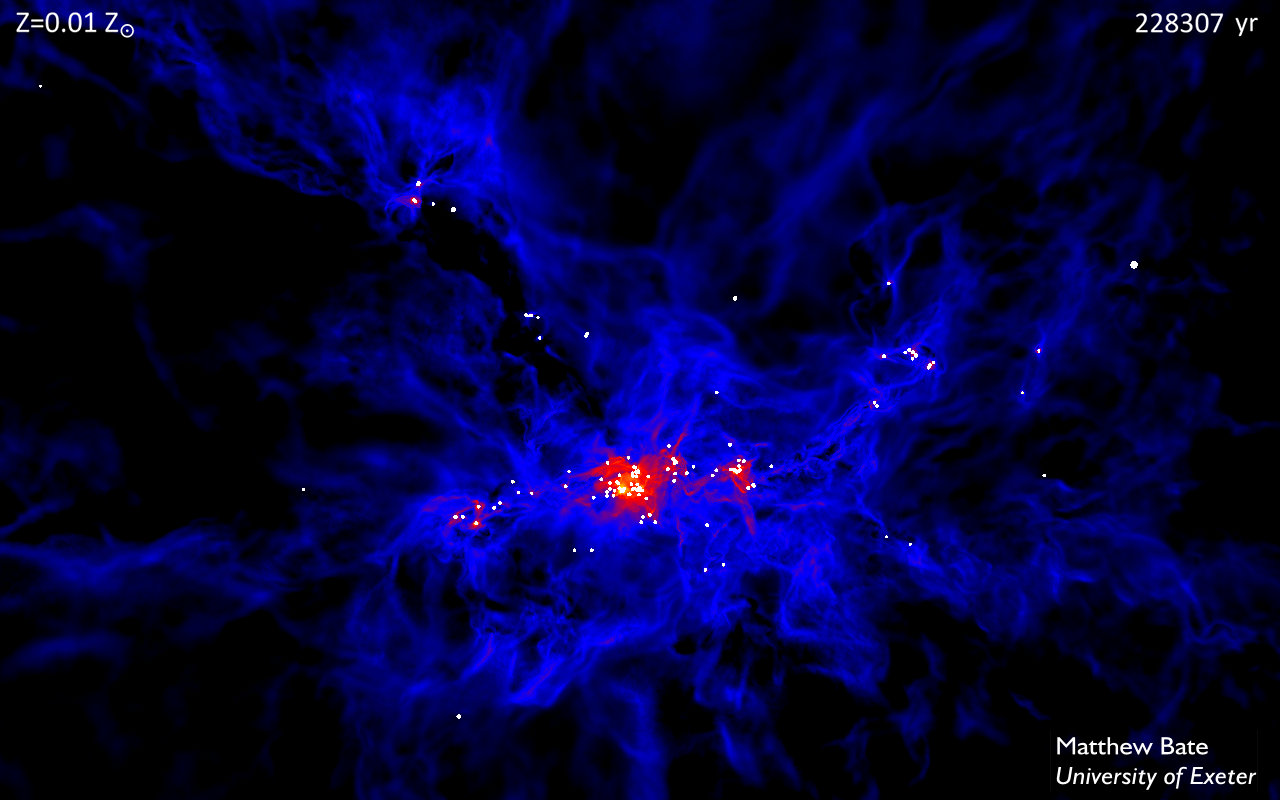 Radiation hydrodynamical simulations of star formation in a 500 solar-mass molecular cloud with different metallicities, ranging from 1/100 to 3 times solar metallicity. More information.
Radiation hydrodynamical simulations of star formation in a 500 solar-mass molecular cloud with different metallicities, ranging from 1/100 to 3 times solar metallicity. More information.
Reference: Bate 2014;
Date first added: 01/2014;
Stellar core and outflow formation in RMHD simulations (2014)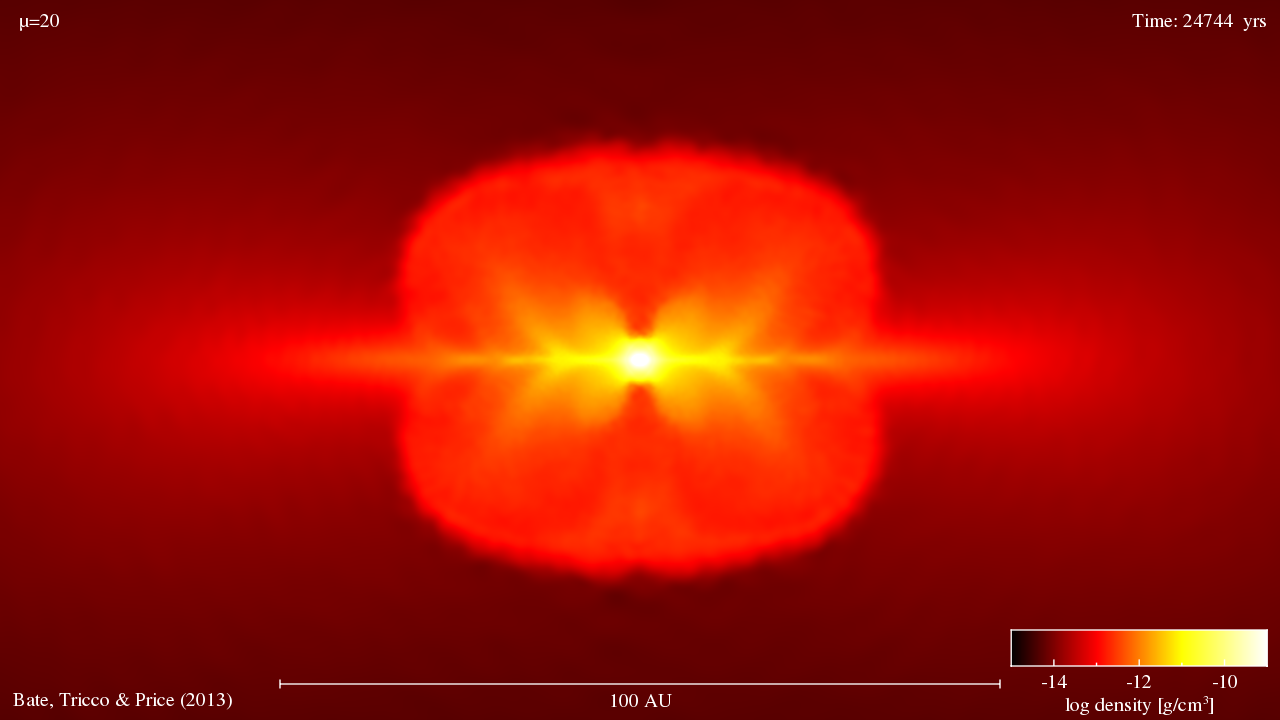 Radiation magnetohydrodynamical simulations of the collapse of 1 solar-mass molecular cloud cores that follow the formation of the first core or pre-stellar disc, a slow magnetically-driven outflow from the first core, the second collapse and the formation of the stellar core, and the launching of a fast outflow from the vicinity of the stellar core. More information.
Radiation magnetohydrodynamical simulations of the collapse of 1 solar-mass molecular cloud cores that follow the formation of the first core or pre-stellar disc, a slow magnetically-driven outflow from the first core, the second collapse and the formation of the stellar core, and the launching of a fast outflow from the vicinity of the stellar core. More information.
Reference: Bate, Tricco & Price 2014; Date first added: 10/2013; Star cluster formation in a 500 solar-mass cloud including radiative feedback (2012)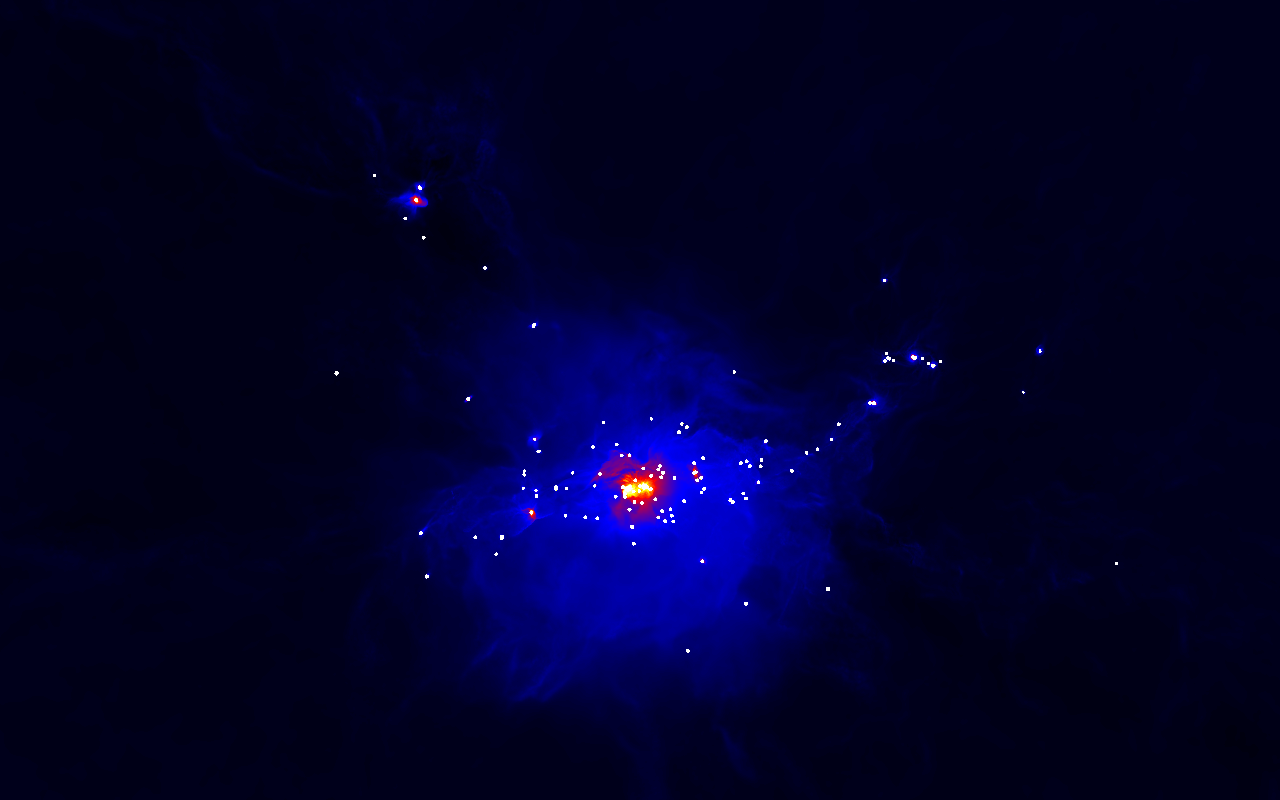 Radiation hydrodynamical simulations of star formation in a 500 solar-mass molecular cloud with high-quality animations. More information.
Radiation hydrodynamical simulations of star formation in a 500 solar-mass molecular cloud with high-quality animations. More information.
Reference: Bate 2012;
Date first added: 07/2011;
The formation and evolution of pre-stellar discs (2011)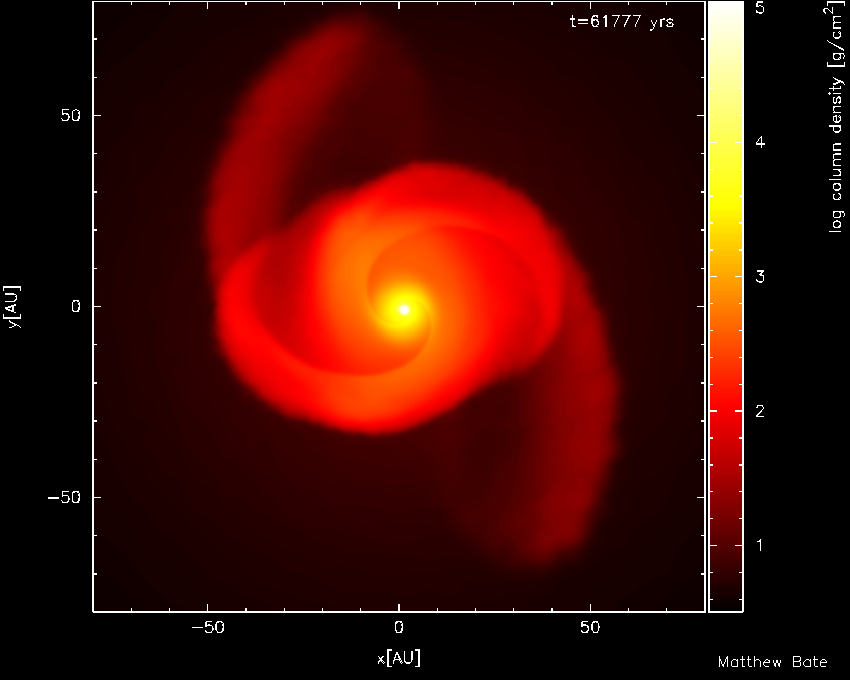 Radiation hydrodynamical simulations of the collapse of 1 solar-mass molecular cloud cores that follow the formation of the first core or pre-stellar disc and its evolution before and after the formation of the stellar core within it. More information.
Radiation hydrodynamical simulations of the collapse of 1 solar-mass molecular cloud cores that follow the formation of the first core or pre-stellar disc and its evolution before and after the formation of the stellar core within it. More information.
Reference: Bate 2011; Date first added: 07/2011; Star cluster formation including radiative feedback (2009)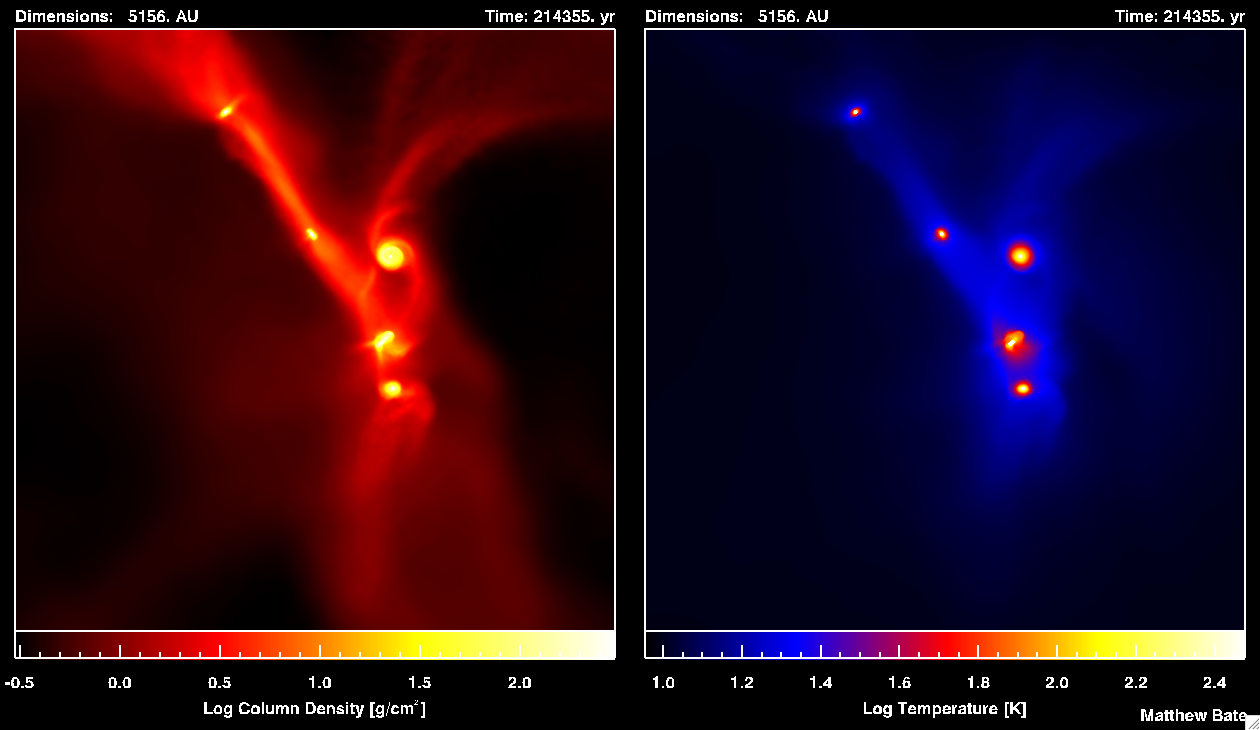 Radiation hydrodynamical simulations of star formation in a 50 solar-mass molecular cloud with high-quality images and animations. More information.
Radiation hydrodynamical simulations of star formation in a 50 solar-mass molecular cloud with high-quality images and animations. More information.
Reference: Bate 2009b;
Date first added: 10/2008;
The largest, most complex hydrodynamical star formation calculation ever performed (2009)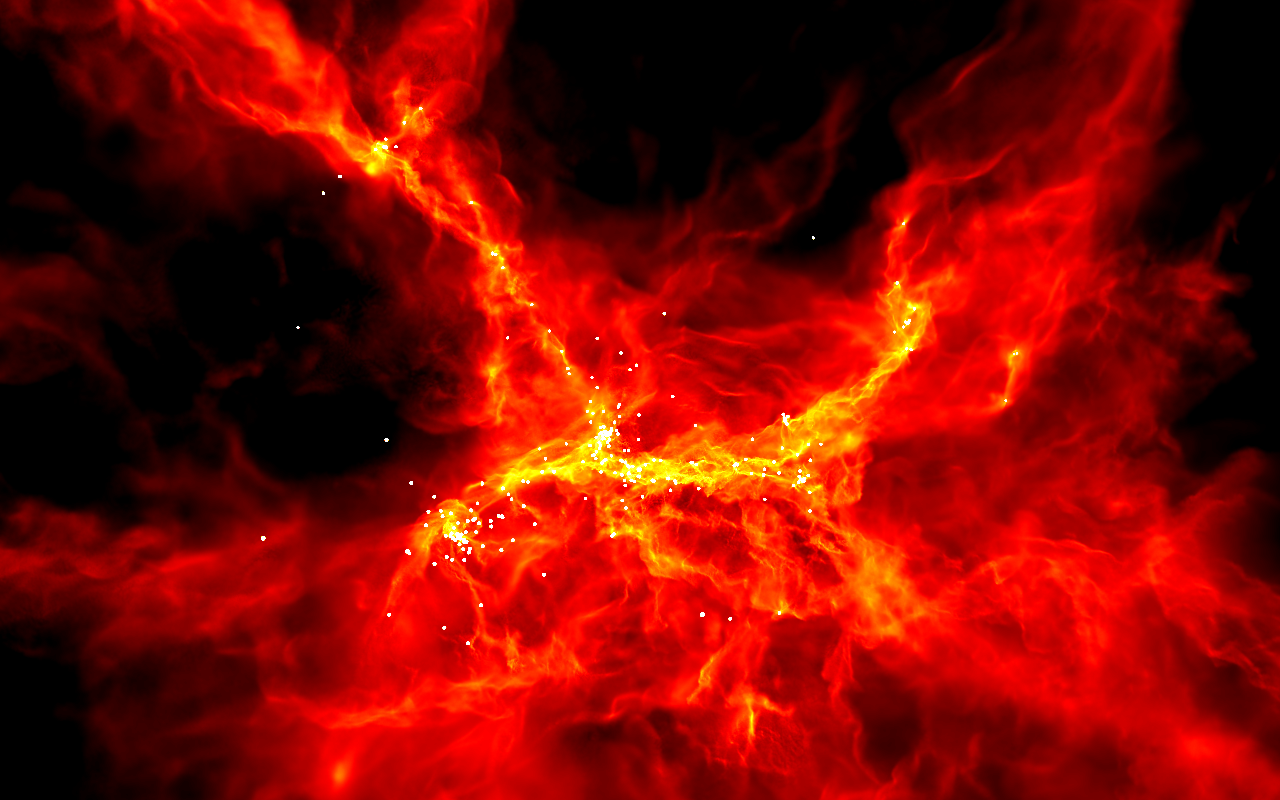 Star formation in a 500 solar-mass molecular cloud with high-quality images and animations. More information.
Star formation in a 500 solar-mass molecular cloud with high-quality images and animations. More information.
Reference: Bate 2009a Star cluster formation calculations (2002-2005)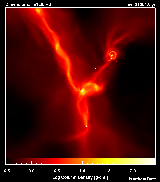 Quicktime, AVI and MPEG-4
32-747 MBytes
Quicktime, AVI and MPEG-4
32-747 MBytesThe first was press-released on April 12, 2002 with high-quality images and animations. Since then four large-scale calculations have been performed. More information. References: Bate,
Bonnell, Bromm 2002a;
Bate, Bonnell, Bromm 2002b; Bate, Bonnell, Bromm
2003 ; Bate & Bonnell
2005 Date first added: 04/2002; Updated 09/2004
Collapse and fragmentation of a molecular cloud core to form a triple system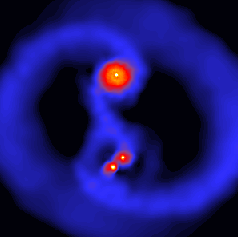 AVI (13MB)
AVI (160MB)
Quicktime (22MB)
AVI (13MB)
AVI (160MB)
Quicktime (22MB)A binary system forms first from an initial m=2 density perturbation in the cloud. Subsequently, one of the protostellar discs fragments to give a third object. The result is a stable triple system surrounded by a circumtriple disc. Reference:
Bate, Bonnell & Price 1995 Date added: 06/2003
The evolution of a protobinary stellar system as it accretes from a gaseous envelope.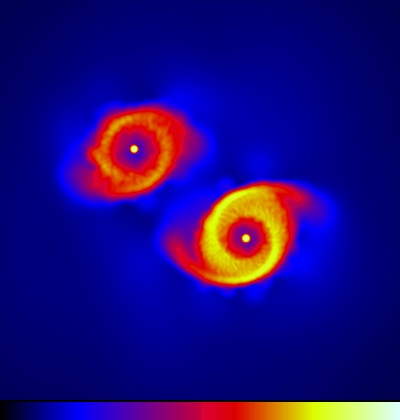 MPEG-1 1.4 MB
MPEG-1 1.4 MBInitial properties of the molecular cloud core: Uniform density, solid-body rotation. More information.
Reference: Bate 2000
Date added: 06/2001
Reference: Bate 2000
Date added: 06/2001
The dynamical rotational instability of the first hydrostatic core that can occur during the collapse of a molecular cloud to form a star.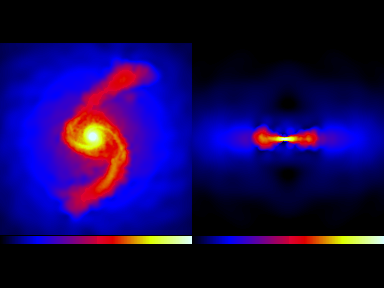 MPEG-1 2.0 MB
MPEG-1 2.0 MBMore information. Reference:
Bate 1998
Date added: 06/2001
About these pagesMany of the theoretical calculations I conduct during my research into star and planet formation result in animations. I will endevour to place as many of these computer simulations as I can on this page. New animations will be added at the top of the page with the dates that they were added. Copyright: Unless otherwise stated, all of the material on this site is the property of Matthew Bate. Any of my pictures and animations may be used freely for non-profit purposes (such as during scientific talks) as long as appropriate credit is given wherever they appear. Permission must be obtained from me before using them for any other purpose (e.g. pictures for publication in books). |

